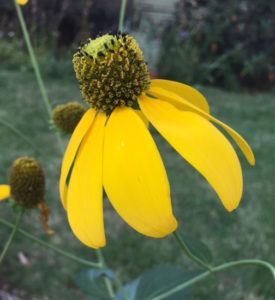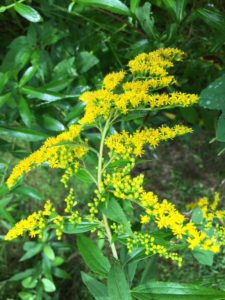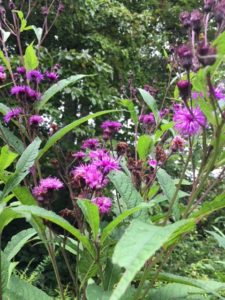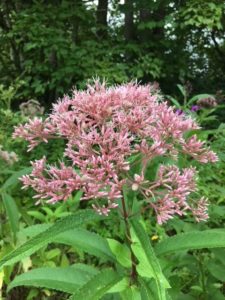
Although in spring, I am down on my knees looking for flowers on the woodland floor, when it comes to the wildflowers of fall, I can see a startlingly brilliant display from the comfort of the passenger seat of the car. (Botanists / wildflower enthusiasts make terrible drivers. Flowers are more distracting than texting!)
Country roadsides these days have turned a kaleidoscope of colors. Waves of goldenrod are interspersed with tall stalks of magenta ironweed and towers of mauve Joe-Pye weed. If you stop the car and get out to look a little closer, you’ll undoubtedly see a half dozen different kinds of yellow daisy like flowers. In the botanical world, these are all affectionately known as (DYCs – damn yellow composites) due to the difficulty in identifying them down to a specific species.
Goldenrod was at one time considered a powerful healing herb, as evidenced by the genus name, Solidago, which means “to make whole” or “to heal.” Both Native American and early Colonial healers used the native goldenrod to treat urinary infections and colic. A poultice made from the leaves was put on cut and bruised skin. Goldenrod tea became popular during the Revolutionary War when drinking imported tea became politically incorrect. One more note about goldenrod: it does not cause hay fever. The real culprit is ragweed, which blooms at the same time.
 Ironweed is easily identified by its profusion of rich, magenta flowers. These plants bloom along southern roadsides from August through October. Ironweed was also valued for its medicinal qualities, particularly by the Cherokees. Both the leaves and roots were used, most often in a tea given during pregnancy and childbirth. The tea was also given to those suffering from stomach ulcers.
Ironweed is easily identified by its profusion of rich, magenta flowers. These plants bloom along southern roadsides from August through October. Ironweed was also valued for its medicinal qualities, particularly by the Cherokees. Both the leaves and roots were used, most often in a tea given during pregnancy and childbirth. The tea was also given to those suffering from stomach ulcers.
Joe-pye weed was named for an Indian medicine man who lived in colonial New England and was most famous for his use of this plant for treating typhoid fever victims. Joe-pye weed was also used to treat coughs, colds and fevers. Known as “Queen of the Meadow” in southern Appalachia, Joe-pye weed is much beloved by both wildflower enthusiasts and bumblebees who will gorge themselves on the nectar until they become groggy.
So, among the weeds and grasses that line our country roads, there are wildflowers of great beauty and splendor. Take a road trip and see what you can find, just let someone else do the driving!
